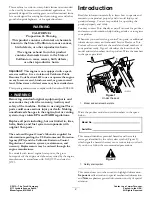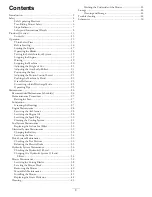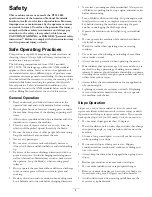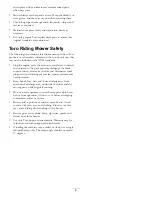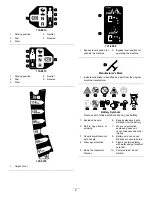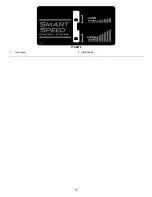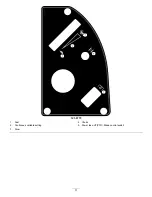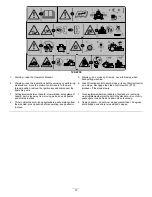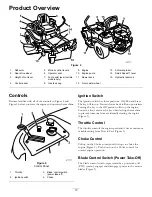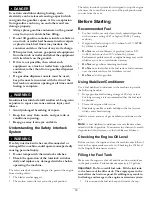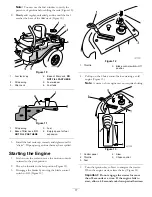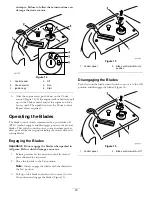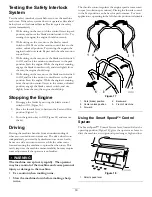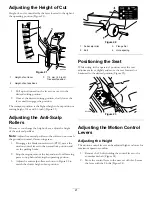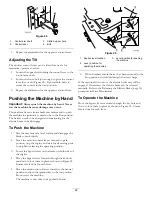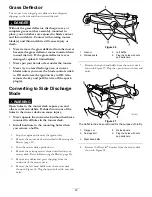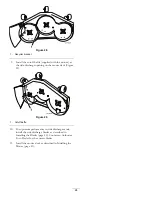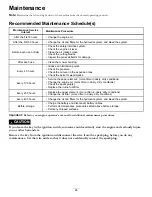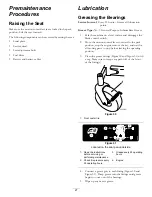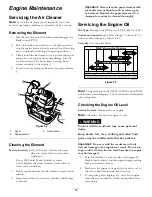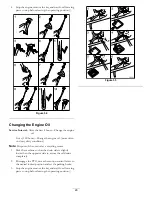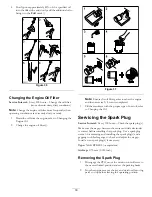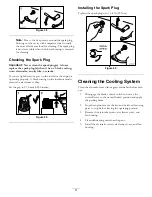
DANGER
In certain conditions during fueling, static
electricity can be released causing a spark which
can ignite the gasoline vapors. A fire or explosion
from gasoline can burn you and others and can
damage property.
•
Always place gasoline containers on the ground
away from your vehicle before filling.
•
Do not fill gasoline containers inside a vehicle or
on a truck or trailer bed because interior carpets
or plastic truck bed liners may insulate the
container and slow the loss of any static charge.
•
When practical, remove gas-powered equipment
from the truck or trailer and refuel the equipment
with its wheels on the ground.
•
If this is not possible, then refuel such
equipment on a truck or trailer from a portable
container, rather than from a gasoline dispenser
nozzle.
•
If a gasoline dispenser nozzle must be used,
keep the nozzle in contact with the rim of the
fuel tank or container opening at all times until
fueling is complete.
WARNING
Gasoline is harmful or fatal if swallowed. Long-term
exposure to vapors can cause serious injury and
illness.
•
Avoid prolonged breathing of vapors.
•
Keep face away from nozzle and gas tank or
conditioner opening.
•
Keep gas away from eyes and skin.
Understanding the Safety Interlock
System
WARNING
If safety interlock switches are disconnected or
damaged the machine could operate unexpectedly
causing personal injury.
•
Do not tamper with the interlock switches.
•
Check the operation of the interlock switches
daily and replace any damaged switches before
operating the machine.
The safety interlock system is designed to prevent the engine
from starting unless:
•
The blades are disengaged.
•
The motion control levers are in the park position.
The safety interlock system also is designed to stop the engine
whenever the control levers are out of the park position and
you rise from the seat.
Before Starting
Recommended Fuel
•
For best results, use only clean, fresh, unleaded gasoline
with an octane rating of 87 or higher ((R+M)/2 rating
method).
•
Oxygenated fuel with up to 10% ethanol or 15% MTBE
by volume is acceptable.
•
Do Not
use ethanol blends of gasoline (such as E15
or E85) with more than 10% ethanol by volume.
Performance problems and/or engine damage may result
which may not be covered under warranty.
•
Do Not
use gasoline containing methanol.
•
Do Not
store fuel either in the fuel tank or fuel containers
over the winter unless a fuel stabilizer is used.
•
Do Not
add oil to gasoline.
Using Stabilizer/Conditioner
Use a fuel stabilizer/conditioner in the machine to provide
the following benefits:
•
Keeps gasoline fresh during storage of 90 days or less.
For longer storage it is recommended that the fuel tank
be drained.
•
Cleans the engine while it runs.
•
Eliminates gum-like varnish buildup in the fuel system,
which causes hard starting.
Add the correct amount of gas stabilizer/conditioner to the
gas.
Note:
A fuel stabilizer/conditioner is most effective when
mixed with fresh gasoline. To minimize the chance of varnish
deposits in the fuel system, use fuel stabilizer at all times.
Checking the Engine Oil Level
Before you start the engine and use the machine, check the oil
level in the engine crankcase; refer to Checking the Oil Level
in the Engine Maintenance section.
Filling the Fuel Tank
Make sure the engine is shut off and the motion controls are
in the park position. Tank maximum capacity is 2.9 gallons.
Important:
Do Not overfill fuel tank. Fill the fuel tank
to the bottom of the filler neck. The empty space in the
tank allows the fuel to expand. Overfilling may result in
fuel leakage or damage to the engine or emission system.
1.
Clean around the fuel tank cap and remove the cap.
16
Summary of Contents for 74395
Page 10: ...119 8874 1 Low speed 2 High speed 10 ...
Page 50: ...Schematics g017655 Electrical Diagram Rev A 50 ...
Page 51: ...Notes 51 ...

